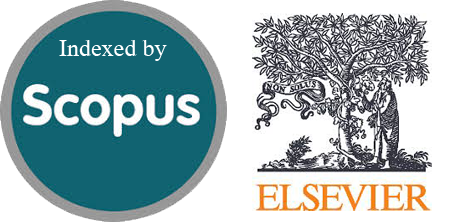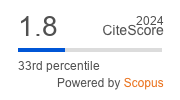Naïve Bayes and TF-IDF for Sentiment Analysis of the Covid-19 Booster Vaccine
Abstract
The booster vaccine polemic became a trending topic on Twitter and reaped many pros and cons. This booster vaccine began to be distributed on January 12, 2022. This booster vaccine program was implemented free of charge for the people of Indonesia to prevent the new variant of Covid-19, Omicron. The contribution of this study is to analyze the sentiment of booster vaccines to prevent covid-19 using the Naïve Bayes and TF-IDF methods. We conducted sentiment analysis to determine whether the tweet was positive, negative, or neutral. The solution used is the Naïve Bayes method and TF-IDF. The role of TF-IDF is to determine how relevant the data in the document is by utilizing word weighting. The stages of this research using CRISP-DM include Business Understanding, Data Understanding, Data Preparation, Modelling, Evaluation, and Deployment. The net data results show 1,557 data with a positive sentiment of 1,335, a neutral sentiment of 171 data, and a negative sentiment of 51 data. The test results with 60:40 data sharing obtained accuracy, precision, and recall values of 85.26%, 85%, and 100%. The results of this test have increased by 7.26%, 12%, and 20% from other previous studies with the same data distribution.
Downloads
References
S. Suhardiman and F. Purwaningtias, “Analisis Sentimen Masyarakat Terhadap Virus Corona Berdasarkan Opini Masyarakat Menggunakan Metode Naïve Bayes Classifier,” J. Pengemb. Sist. Inf. dan Inform., vol. 2, no. 4, pp. 220–232, 2020.
M. W. A. Putra, S. Susanti, E. Erlin, and H. Herwin, “Analisis Sentimen Dompet Elektronik Pada Media Sosial Twitter Menggunakan Naïve Bayes Classifier,” IT J. Res. Dev., vol. 5, no. 1, pp. 72–86, 2020.
D. Darwis, N. Siskawati, and Z. Abidin, “Penerapan Algoritma Naive Bayes untuk Analisis Sentimen Review Data Twitter BMKG Nasional,” J. Tekno Kompak, vol. 15, no. 1, pp. 131–145, 2021.
N. P. G. Naraswati, D. C. Rosmilda, D. Desinta, F. Khairi, R. Damaiyanti, and R. Nooraeni, “Analisis Sentimen Publik dari Twitter Tentang Kebijakan Penanganan Covid-19 di Indonesia dengan Naive Bayes Classification,” Sist. J. Sist. Inf., vol. 10, no. 1, pp. 228–238, 2021.
Samsir, Kusmanto, Abdul Hakim Dalimunthe, Rahmad Aditiya, and Ronal Watrianthos, “Implementation Naïve Bayes Classification for Sentiment Analysis on Internet Movie Database,” Building of Informatics, Technology and Science (BITS), vol. 4, no. 1, pp. 1–6, Jun. 2022.
A. A. Permana, M. F. Fahrezi, D. Y. Priyanggodo, D. A. Kristiyanti, and M. Sihotang, “Sentimen Analisis Opini Masyarakat Pada Media Sosial Twitter Terhadap Vaksin Berbayar Menggunakan Metode Naïve Bayes Classifier (NBC),” JTS J. Tek., vol. 10, no. 2, pp. 84–92, 2021.
F. Fathonah and A. Herliana, “Penerapan Text Mining Analisis Sentimen Mengenai Vaksin Covid - 19 Menggunakan Metode Naïve Bayes,” J. Sains dan Inform., vol. 7, no. 2, pp. 155–164, 2021, doi: 10.34128/jsi.v7i2.331.
R. Watrianthos, M. Giatman, W. Simatupang, R. Syafriyeti, and N. K. Daulay, “Analisis Sentimen Pembelajaran Campuran Pada Twitter Data Menggunakan Algoritma Naïve Bayes,” Analisis Sentimen Pembelajaran Campuran Pada Twitter Data Menggunakan Algoritma Naïve Bayes, vol. 6, no. 1, pp. 166–170, 2022, doi: http://dx.doi.org/10.30865/mib.v6i1.3383.
N. M. A. J. Astari, D. G. H. Divayana, and G. Indrawan, “Analisis Sentimen Dokumen Twitter Mengenai Dampak Virus Corona Menggunakan Metode Naive Bayes Classifier,” J. Sist. dan Inform., vol. 15, no. 1, pp. 22–29, 2020, doi: 10.30864/jsi.v15i1.332.
Samsir et al., “Naives Bayes Algorithm for Twitter Sentiment Analysis,” J Phys Conf Ser, vol. 1933, no. 1, p. 012019, 2021, doi: 10.1088/1742-6596/1933/1/012019.
R. Watrianthos, S. Suryadi, D. Irmayani, M. Nasution, and E. F. S. Simanjorang, “Sentiment analysis of traveloka app using naïve bayes classifier method,” International Journal of Scientific and Technology Research, vol. 8, no. 7, pp. 786–788, 2019, doi: 10.31227/osf.io/2dbe4.
M. M. M. Olhang, S. Achmadi, and F. X. Ariwibisono, “Analisis Sentimen Pengguna Twitter Terhadap Covid-19 Di Indonesia Menggunakan Metode Naïve Bayes Classifier (NBC),” JATI (Jurnal Mhs. Tek. Inform., vol. 4, no. 2, pp. 214–221, 2020.
F. Septianingrum, J. H. Jaman, and U. Enri, “Analisis Sentimen Pada Isu Vaksin Covid-19 di Indonesia dengan Metode Naive Bayes Classifier,” J. Media Inform. Budidarma, vol. 5, no. 4, pp. 1431–1437, 2021, doi: 10.30865/mib.v5i4.3260.
D. N. Fitriana and Y. Sibaroni, “Sentiment Analysis on KAI Twitter Post Using Multiclass Support Vector Machine (SVM),” Resti J., vol. 4, no. 5, pp. 846–853, 2020.
T. F. Berlian, A. Herdiani, and W. Astuti, “Analisis Sentimen Opini Masyarakat Terhadap Acara Televisi pada Twitter dengan Retweet Analysis dan Naïve Bayes Classifier,” in e-Proceeding of Engineering, 2019, vol. 6, no. 2, pp. 8660–8667.
Samsir, Ambiyar, U. Verawardina, F. Edi, and R. Watrianthos, “Analisis Sentimen Pembelajaran Daring Pada Twitter di Masa Pandemi COVID-19,” JURNAL MEDIA INFORMATIKA BUDIDARMAJURNAL MEDIA INFORMATIKA BUDIDARMA, vol. 5, no. 10, pp. 174–179, 2021, doi: 10.30865/mib.v4i4.2293.
W. Yulita, E. D. Nugroho, and M. H. Algifari, “Analisis Sentimen Terhadap Opini Masyarakat Tentang Vaksin Covid - 19 Menggunakan Algoritma Naïve Bayes Classifier,” JDMSI, vol. 2, no. 2, pp. 1–9, 2021.
Y. Suhanda, I. Kurniati, and S. Norma, “Penerapan Metode Crisp-DM Dengan Algoritma K-Means Clustering Untuk Segmentasi Mahasiswa Berdasarkan Kualitas Akademik,” J. Teknol. Inform. dan Komput. MH Thamrin, vol. 6, no. 2, pp. 12–20, 2020.
T. Wurijanto, H. B. Setiawan, and A. B. Tjandrarini, “Penerapan Model CRISP-DM pada Prediksi Nasabah Kredit yang Berisiko Menggunakan Algoritma Support Vector Machine,” vol. 10, 2022.
B. Gunawan, H. S. Pratiwi, and E. E. Pratama, “Sistem Analisis Sentimen pada Ulasan Produk Menggunakan Metode Naive Bayes,” JEPIN (Jurnal Edukasi dan Penelit. Inform., vol. 4, no. 2, pp. 113–118, 2018.
A. Hendra, “Analisis Sentimen Review Halodoc Menggunakan Naive Bayes Classifier,” JISKa, vol. 6, no. 2, pp. 78–89, 2021.
D. D. Putri, G. F. Nama, and W. E. Sulistiono, “Analisis Sentimen Kinerja Dewan Perwakilan Rakyat (DPR) Pada Twitter Menggunakan Metode Naive Bayes Classifier,” J. Inform. dan Tek. Elektro Terap., vol. 10, no. 1, pp. 34–40, 2022.
A. P. Maharani and A. Triayudi, “Sentiment Analysis of Indonesian Digital Payment Customer Satisfaction Towards GOPAY, DANA, and ShopeePay Using Naïve Bayes and K-Nearest Neighbour Methods,” J. Media Inform. Budidarma, vol. 6, no. 1, pp. 672–680, 2022, doi: 10.30865/mib.v6i1.3545.
M. T. A. Bangsa, S. Priyanta, and Y. Suyanto, “Aspect-Based Sentiment Analysis of Online Marketplace Reviews Using Convolutional Neural Network,” IJCCS (Indonesian J. Comput. Cybern. Syst., vol. 14, no. 2, pp. 123–134, 2020, doi: 10.22146/ijccs.51646.
L. Mayasari and D. Indarti, “Klasifikasi Topik Tweet Mengenai Covid Menggunakan Metode Multinomial Naive Bayes Dengan Pembobotan TF-IDF,” J. Ilm. Inform. Komput., vol. 27, no. 1, pp. 43–53, 2022.
L. A. Andika, P. A. N. Azizah, and R. Respatiwulan, “Analisis Sentimen Masyarakat terhadap Hasil Quick Count Pemilihan Presiden Indonesia 2019 pada Media Sosial Twitter Menggunakan Metode Naive Bayes Classifier,” Indones. J. Appl. Stat., vol. 2, no. 1, pp. 34–41, 2019.
Copyright (c) 2023 Jurnal RESTI (Rekayasa Sistem dan Teknologi Informasi)

This work is licensed under a Creative Commons Attribution 4.0 International License.
Copyright in each article belongs to the author
- The author acknowledges that the RESTI Journal (System Engineering and Information Technology) is the first publisher to publish with a license Creative Commons Attribution 4.0 International License.
- Authors can enter writing separately, arrange the non-exclusive distribution of manuscripts that have been published in this journal into other versions (eg sent to the author's institutional repository, publication in a book, etc.), by acknowledging that the manuscript has been published for the first time in the RESTI (Rekayasa Sistem dan Teknologi Informasi) journal ;








